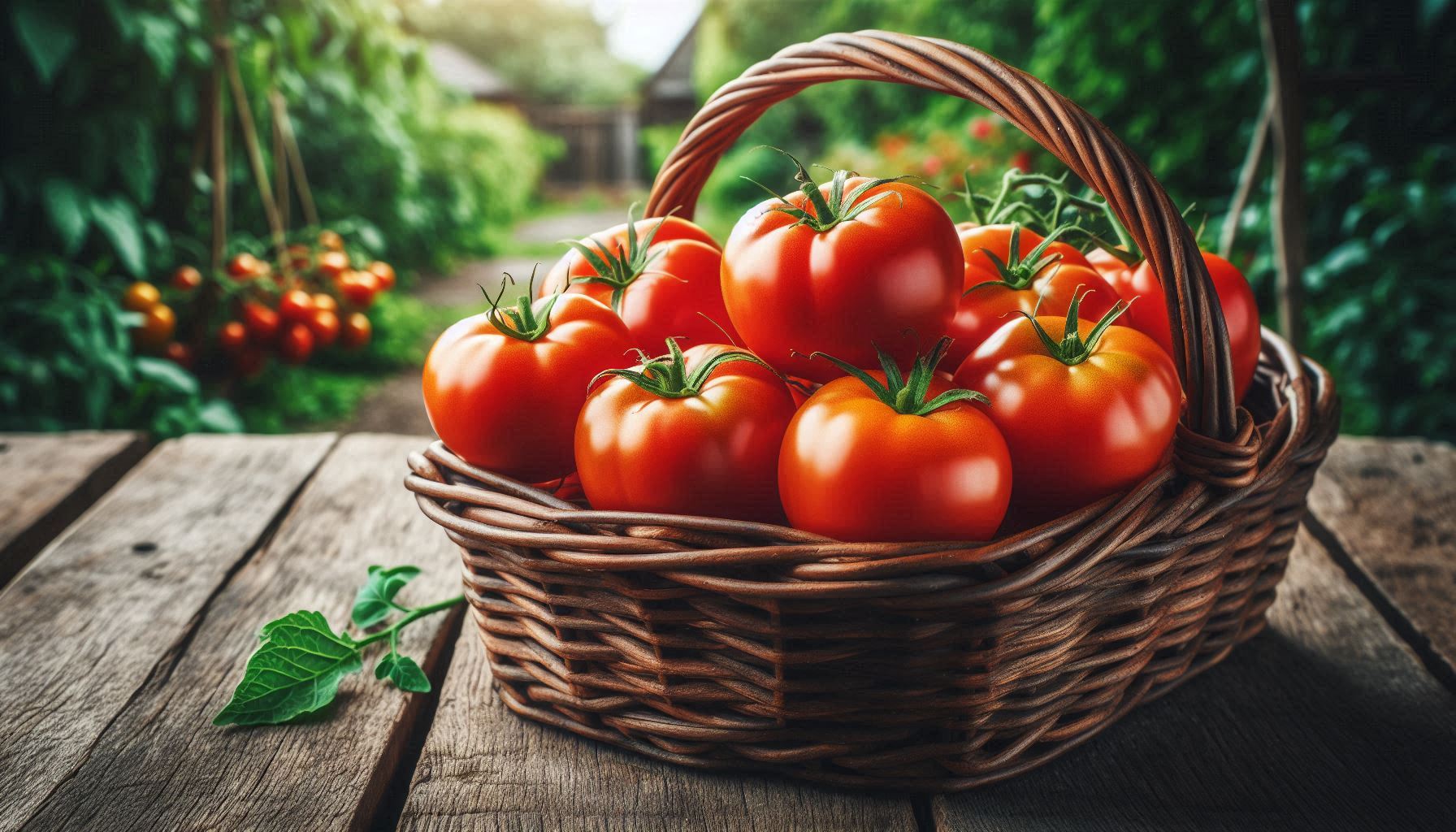As the warm sun begins to rise earlier and set later, the allure of summer produce captivates the senses, with organic tomatoes leading the charge. These vibrant fruits—bursting with flavor and nutrients—are more than just a culinary delight; they represent a movement towards sustainability and health-conscious eating. The journey of organic tomatoes from farm to table is a testament to the dedication of farmers, the importance of environmental stewardship, and the pleasure of fresh, seasonal eating. In this exploration, we’ll delve into the growing process, the benefits of organic farming, and the myriad ways to enjoy these succulent tomatoes at home.
The Life Cycle of an Organic Tomato
- Planting and Cultivation:
- The journey of an organic tomato begins in the fertile soil of an organic farm. Unlike conventional farming, organic farming eschews synthetic pesticides and fertilizers, relying instead on natural methods to promote plant health. Farmers start by selecting heirloom or hybrid varieties known for their flavor, size, and resilience.
- Seeds are sown in rich, well-draining soil, often supplemented with organic compost. This nutrient-rich amendment not only feeds the plants but also improves soil structure and encourages beneficial microbial life. Proper spacing is crucial; it allows air circulation and reduces the risk of diseases. Farmers often companion plant—growing different crops together—to naturally deter pests and enhance growth.
- Watering and Care:
- Once planted, organic tomatoes require diligent care. Farmers employ drip irrigation to deliver water directly to the root zone, minimizing waste and promoting healthy growth. This method is particularly beneficial in regions where water conservation is paramount. Regular monitoring is essential to identify any early signs of pests or diseases, which are managed through organic methods like neem oil, insecticidal soaps, or introducing beneficial insects such as ladybugs.
- Harvesting:
- Harvest time is a crucial phase. Organic tomatoes are typically handpicked at their peak ripeness to ensure the best flavor. Farmers understand that tomatoes continue to ripen after being harvested, and picking them at the right time can mean the difference between bland and bursting with flavor. Once harvested, tomatoes are handled with care to avoid bruising, which can affect their quality.
The Benefits of Organic Tomatoes:
- Nutritional Value: Organic tomatoes are not only flavorful but also packed with essential nutrients. They are rich in vitamins A, C, and K, potassium, and antioxidants like lycopene, which is known for its potential health benefits, including reducing the risk of certain cancers and heart disease. Studies suggest that organic tomatoes often have higher levels of these nutrients compared to conventionally grown counterparts, largely due to the soil health and farming practices used.
- Environmental Impact: Choosing organic tomatoes also supports environmentally sustainable practices. Organic farming promotes biodiversity, improves soil health, and reduces pollution from synthetic fertilizers and pesticides. By prioritizing natural methods, organic farmers help protect ecosystems and promote a healthier environment for future generations.
- Supporting Local Economies: Buying organic tomatoes directly from local farmers’ markets or community-supported agriculture (CSA) programs strengthens local economies. When consumers support local farmers, they help sustain small-scale agriculture, which is vital for maintaining food diversity and local food security. Additionally, locally grown tomatoes typically have a smaller carbon footprint than those transported long distances.
The Culinary Delight of Organic Tomatoes:
Flavor Profile:
One of the most compelling reasons to choose organic tomatoes is their unparalleled flavor. The commitment to natural farming practices allows the tomatoes to develop rich, complex flavors that are often absent in mass-produced varieties. Organic tomatoes are usually more flavorful, sweeter, and juicier, making them perfect for a wide range of culinary applications.
Ways to Enjoy Organic Tomatoes
- Fresh Salads: The simplest way to savor organic tomatoes is in a fresh salad. Combine sliced heirloom varieties with fresh basil, mozzarella, and a drizzle of balsamic glaze for a Caprese salad that sings with summer flavors.
- Sauces and Soups: Transform ripe organic tomatoes into a rich marinara sauce or a comforting tomato soup. The depth of flavor from organic tomatoes elevates these dishes, making them a family favorite.
- Salsas and Bruschetta: Fresh salsas made with organic tomatoes, onions, cilantro, and lime juice are perfect for dipping chips or topping grilled fish. Bruschetta topped with diced organic tomatoes, garlic, and olive oil is a simple yet elegant appetizer.
- Roasting and Grilling: Roasting or grilling organic tomatoes intensifies their natural sweetness. Toss halved tomatoes with olive oil, salt, and herbs, then roast them until caramelized. These make a delicious side dish or a topping for pasta.
- Canning and Preserving: With an abundance of tomatoes, canning is a fantastic way to enjoy their flavor year-round. Organic tomatoes can be canned into sauces, salsa, or even dried for use in soups and stews.
Recipes to Try
1. Heirloom Tomato Salad
Ingredients:
- 4 cups heirloom tomatoes, sliced
- 1 cup fresh mozzarella, sliced
- Fresh basil leaves
- 2 tablespoons olive oil
- 1 tablespoon balsamic vinegar
- Salt and pepper to taste
Instructions:
- Arrange tomato and mozzarella slices on a platter.
- Tuck in fresh basil leaves.
- Drizzle with olive oil and balsamic vinegar, then season with salt and pepper.
- Serve immediately.
- Roasted Tomato Pasta

2. Roasted Cherry Tomato Pasta
Ingredients:
- 2 cups cherry tomatoes, halved
- 3 cloves garlic, minced
- 1 tablespoon olive oil
- Salt and pepper to taste
- 8 ounces pasta of choice
- Fresh basil for garnish
- Grated Parmesan cheese
Instructions:
- Preheat oven to 400°F (200°C).
- Toss cherry tomatoes and garlic with olive oil, salt, and pepper. Spread on a baking sheet and roast for 20 minutes.
- Cook pasta according to package instructions. Drain and reserve some pasta water.
- Combine pasta with roasted tomatoes and garlic. Add reserved pasta water as needed for desired consistency.
- Garnish with fresh basil and grated Parmesan before serving.

The Importance of Eating Seasonally
Eating organic tomatoes in season is not only more flavorful but also more sustainable. Seasonal eating reduces the carbon footprint associated with transporting out-of-season produce and allows consumers to enjoy food at its peak freshness. In many regions, organic tomatoes are typically in season from late summer to early fall, providing ample opportunity to indulge in their delightful taste.
The Growing Seasons
The specific timing for organic tomato cultivation can vary based on climate. Generally, tomatoes are planted in late spring and harvested through the summer months. The warm temperatures and long days are ideal for the growth of this sun-loving fruit.
Farmers often utilize crop rotation and cover cropping to maintain soil health and fertility. After the tomato season ends, many farmers plant cover crops to enrich the soil, prevent erosion, and suppress weeds, ensuring that the land remains productive for future growing seasons.
Challenges in Organic Tomato Farming
- Pests and Diseases: Despite the benefits, organic tomato farming does come with its challenges. Organic farmers must remain vigilant against pests and diseases. While chemical solutions are off the table, farmers often employ a mix of preventive measures, such as crop rotation, companion planting, and organic pesticides when necessary.
- Weather Dependence: Organic tomato yields can also be affected by weather conditions. Excessive rain can lead to diseases like blight, while drought conditions can stress plants and reduce fruit quality. Farmers are increasingly adopting sustainable practices, such as mulching and cover cropping, to help mitigate these risks and adapt to changing climate conditions.
- Market Competition: The organic market is growing, and while this is positive for consumers, it also means increased competition for farmers. Ensuring that their produce stands out in terms of quality and flavor requires dedication and a commitment to organic practices. Building relationships with consumers through farmers’ markets and local sales is crucial for success.
Benefits of Organic Tomatoes
Organic tomatoes offer a range of benefits that make them a great choice for health-conscious consumers and environmentally aware individuals. Here are some key advantages:
- Nutritional Value: Organic tomatoes are rich in vitamins A, C, and K, as well as potassium and dietary fiber. They also contain antioxidants like lycopene, which may help reduce the risk of certain diseases, including heart disease and cancer.
- Flavor: Many people find organic tomatoes to be more flavorful and aromatic than their conventional counterparts. This is often due to the farming practices used, which allow the fruits to develop fully on the vine.
- No Synthetic Chemicals: Organic tomatoes are grown without synthetic pesticides, herbicides, or fertilizers. This means fewer chemicals are present in your food and in the environment.
- Environmental Sustainability: Organic farming practices promote biodiversity, improve soil health, and reduce pollution. By choosing organic, consumers support sustainable agriculture that benefits the ecosystem.
- Support for Local Economies: Buying organic tomatoes from local farmers or farmers’ markets helps support small-scale agriculture and keeps money within the local community.
- Better for Soil Health: Organic farming methods enhance soil fertility through crop rotation and the use of organic compost, leading to healthier crops over time.
- Biodiversity: Organic farms often cultivate a diverse array of plants and animals, contributing to greater biodiversity, which is crucial for ecological balance.
- Lower Carbon Footprint: Local organic tomatoes typically have a smaller carbon footprint than conventionally grown tomatoes that are transported long distances, as they don’t require as much energy for transportation.
- Reduced Risk of Antibiotic Resistance: Organic farming prohibits the use of antibiotics in animal farming, which is linked to the rise of antibiotic-resistant bacteria, a growing public health concern.
- Ethical Considerations: Organic farming practices often prioritize animal welfare and humane treatment, which can resonate with ethically minded consumers.
Choosing organic tomatoes not only contributes to personal health but also supports a more sustainable and equitable food system.
Conclusion
The journey from farm to table illustrates the richness of organic tomatoes, highlighting their unparalleled flavor, nutritional benefits, and positive environmental impact. By choosing organic, consumers support sustainable farming practices and local economies, all while enjoying the true taste of summer. As we savor fresh salads, hearty sauces, and vibrant dishes, let us celebrate the farmers dedicated to growing organic tomatoes and the seasonal rhythm of the harvest. This season, embrace the bounty of organic tomatoes, and allow their fresh, delicious flavors to inspire your culinary creations.
SOURCES
Baranski, M., Srednicka-Tober, D., Błaszczak, W., et al. (2014) – Higher antioxidant and lower cadmium concentrations in organically grown crops: A systematic literature review and meta-analysis. British Journal of Nutrition.
Gómez, I., & Lichtenstein, A. H. (2020) – Organic foods: A comprehensive review of their benefits and limitations. Journal of Nutritional Science.
Kwiatkowski, J., & Szajdak, L. (2019) – The role of organic farming in sustainable development. Agriculture and Agricultural Science Procedia.
Magkos, F., Arvaniti, F., & Zampelas, A. (2006) – Organic food: Nutritional quality and safety. Critical Reviews in Food Science and Nutrition.
Smith, J. (2015) – The organic tomato: An economic and environmental perspective. New York, NY: Greenleaf Publishing.
U.S. Department of Agriculture (USDA). (2021) – Organic production and marketing.
Wszelaczyńska, E., & Grodzinski, W. (2020) – The impact of organic farming on biodiversity and the environment. Agriculture, Ecosystems & Environment.
Zepeda, L., & Leviten-Reid, C. (2004) – Consumers’ purchasing decisions for organic produce. Journal of Consumer Affairs.
HISTORY
Current Version
October 22, 2024
Written By:
BARIRA MEHMOOD
